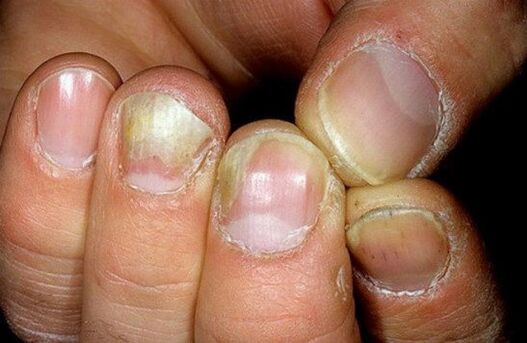Onychomycosis is an infectious disease of the nails caused by pathogenic fungi. According to statistics, it happens to every ten people on the planet. About one-third of nail lesions are fungal infections. More than 30% of cases occur in patients over the age of 65. Toenail fungus is 3-5 times more common than on hands.
Causes of Nail Fungus
The disease starts with an infection of the nail plate, which usually occurs in public places - swimming pools, saunas and bathrooms. Scales with pathogen spores land on floors, benches, paths and carpets. Moist and warm conditions allow the fungus to survive and thrive, especially on unpainted wooden objects. Wearing tight shoes increases the chance of infection.
If one of the household members is sick, there is a high risk of spreading the disease through towels, rugs or grills in the bathroom. Nails on the hands are mainly infected when combing the affected skin area. The risk of this disease increases with repeated injuries to the nails, decreased blood circulation to the extremities, and severe comorbidities (diabetes, AIDS, systemic blood disorders).
Symptoms and types of onychomycosis

There are three forms of the disease - atrophic (onychomycosis), normotrophic and hypertrophic onychomycosis. Characteristic symptoms are:
- White or yellow spots on the thickness of the nail plate;
- The inflammatory process of the periungual roller;
- atrophy of the nails separated from the bed;
- Dystrophic processes in the nail plate.
With atrophic onychomycosis, the nail plate turns gray-brown, shrinks, and separates from the bed. A loose layer is formed on the exposed areas. The hypertrophic type is characterized by hyperkeratosis of the subcutaneous skin, resulting in pain on walking, shape changes, and nail destruction. The nail plate becomes dull and thick. With nutritionally normal onychomycosis, the nails do not thicken and stay shiny. Stripes and spots appear on the nail plate, changing its color.
Nail Fungus Treatment
Treatment of onychomycosis begins immediately after diagnosis as the infection progresses rapidly. Topical antifungal treatment is only effective in the initial phase. As the disease progresses, the use of systemic drugs is necessary.
For safe and effective systemic treatment of toenail fungus, there are a few rules to follow:
- Treatment should only be started after the diagnosis has been confirmed and a doctor has been consulted, as antifungals have many serious side effects. Self-selected doses are not acceptable.
- During systemic antifungal therapy, the use of drugs other than important drugs should be limited.
- The affected area of the nail should be removed after softening with a keratolytic patch.
- To prevent digestive disorders during treatment, foods that can cause bloating - brown bread, dairy, cabbage, beans, are excluded from the diet.
- You need to choose comfortable shoes that don't squeeze your feet.
Treating onychomycosis of the nails at home
Traditional medicine offers several treatments that can help speed recovery, but they can only be used in conjunction with the primary treatment.
- Treat the affected nail with a 5% iodine solution 2 times a day. During application, a slight burning sensation should be observed. When severe pain occurs, treatment should be discontinued.
- To facilitate the separation of infected nails and to promote regeneration, a 20% propolis tincture is applied to the affected area 2-3 times a day.
- Take a small piece of kombucha and apply it to the nails of your washed and steamed feet. Leave on overnight, remove in the morning, rinse with water and remove softened areas of nails. Treat the affected area with an antiseptic. The course of treatment is 2-3 weeks.
- Grate and compress the garlic head and apply the porridge to the infected nail for 10-15 minutes.
Prevention and prognosis of onychomycosis
To prevent disease, pay attention to personal hygiene and do not use other people's clothes, shoes and towels. In bathrooms, swimming pools and saunas, walk only in slippers and avoid contact with places where pathogens may accumulate (wooden trays and carpets). You need to wear comfortable shoes to avoid damaging your nails and prevent your feet from sweating too much.
The prognosis is good, and full recovery can take anywhere from a few weeks to a year, depending on the severity of the disease. After the damaged nails are removed, the treatment effect is enhanced. Reinfection may occur if personal hygiene rules are not followed.
a photo



















